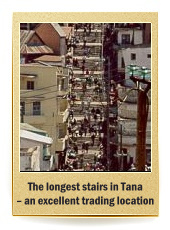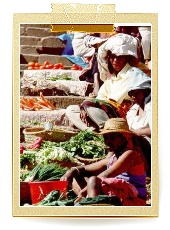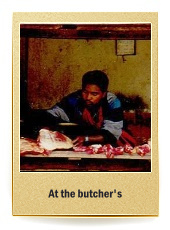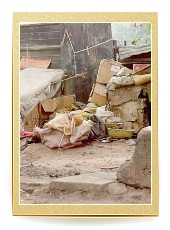Antanarivo
After an 11-hour flight from Paris, when I finally arrived in Tana (which is shorthand for the Malagasy capital), there were two things awaiting me: a half an hour waiting line to get a visa, and a meeting with friar Roman from the congregation of Missionary Oblates of Mary Immaculate. I was lucky to have him pick me up, because otherwise I wouldn’t have known where to go or what to do in a foreign land at 11 pm, not being able to communicate with the locals. It turned out they didn’t speak English, and I didn’t speak French at all. What a nuisance!
I have to stress that the help of the Oblates proved invaluable on many more occasions during my journey.
Friar Roman, who welcomed me, was accompanied by Marek Dworski – someone just as nuts as I am. Before I came, he had spent a whole month on the Red Island (as Madagascar is nicknamed due to the omnipresent laterite soils with shades of orange and brown). He covered a distance of almost 2000 km. We could not travel together though – he left a day after my arrival. Thanks to him I avoided carrying too much unnecessary luggage. He knew exactly what could come in handy and what was superfluous. Just before departure I bought a lightweight 1 kg tent, but while still in Poland, I decided not to take it with me (even though I wasn't sure if it was a wise decision). As it turned out later, I did the right thing. Another redundant item was a billycan, which I left with the Oblates. In every place I reached I could get water and something to eat, which was a blessing – everyone knows how much time cooking takes. What I was truly worried about was water – would mineral water be available, or would I have to boil water? Fortunately, all shops sold mineral water, so it wasn't a problem at all. Marek told me a few interesting stories that he had heard while sightseeing around the island. After talking to him all night long, I felt mentally prepared for what was about to happen.


The next day brought a cultural shock. During a walk to the centre of Tana, I was overwhelmed by everything that surrounded me. Seeing my eyes wide open and my face expressing utter astonishment, Marek laughed at me. For him it was nothing out of the ordinary, but for me – a complete revelation! The streets were filled with cars, starting from old, dilapidated Citroens (the famous 'Duck' model) to the newest BMWs and cross-country vehicles. Reportedly, even one Polish Polonez and two Fiats 125 can be found in the streets of Tana, not to mention a small Fiat 126! People were walking to and fro among honking vehicles. About a metre from the road edge stood stalls full of various goods. In the temperature of 40 degrees Centigrade flip-flops or clothes would not have caught my attention, but raw fish or meat was simply shocking!!!

Anyway, sooner or later you can get used to anything. I know that when the meat turns green, when it is completely covered with swarming flies, then the Malagasy add hot spices to make sausages, and when even those turn black, they will be sold roasted. I never stopped wondering how on earth they could eat it! Probably they have developed immunity. A few metres away, people traded in charcoal. The coal dealers were literally black from head to toes. Still farther, a woman sitting on the sidewalk was breast-feeding her baby wrapped in a piece of fabric. There was litter scattered everywhere, and nobody cleaned it – well, maybe once a month. There were no dustbins – people simply dropped leftovers on the street. A few metres further on, yet another scene: a child playing on a heap of rubbish near a cardboard shack.

However, as I kept walking for another half a kilometre or so, I saw magnificent villas with high walls separating them from the grim reality. With 1.5 million inhabitants, this vast city is a particularly vivid example of contrasts, so characteristic of Madagascar.



